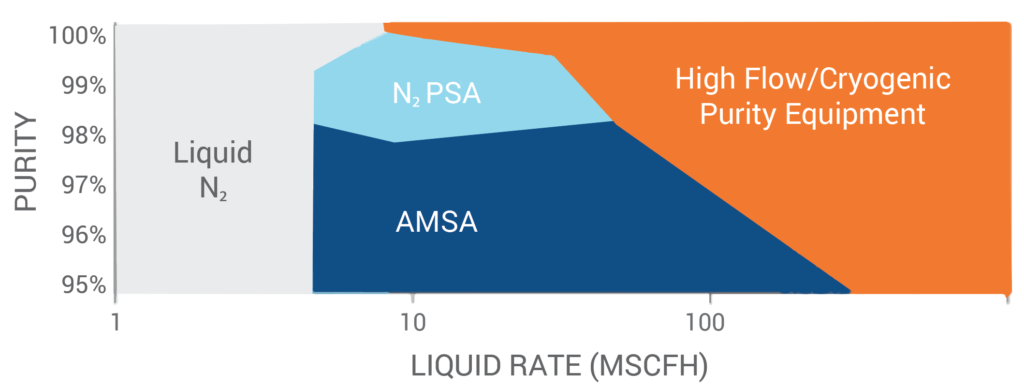A common question among high-volume nitrogen users is often, “How do I know which nitrogen supply method best suits my needs?” With such a wide variety of possible supply methods available, including cylinders, MicroBulk and bulk supply, as well as on-site nitrogen gas generation, it can be tricky to know where to start.
For on-site nitrogen gas generation, the effectiveness of a supply solution depends on many factors such as purity, pressure, flow rate, flow pattern and the conditions at your site. Prean Chetty, On-site Commercial Manager at Airgas, an Air Liquide company, addresses the key questions and answers that may arise when choosing a nitrogen supply solution.
What are the benefits of on-site nitrogen generation?
On-site nitrogen generation can be 25 to 40 percent less expensive than bulk liquid nitrogen. Since nitrogen is produced in liquid form and trucked to your site, there are significant costs related to liquefaction and diesel. Using on-site nitrogen generation reduces costs and your carbon footprint since the energy use related to delivery is minimized.
On-site nitrogen generation has a variety of applications within a diverse range of markets. They include pharmaceuticals, food, packaging, chemical storage and material processing.
If an application has specific purity needs, which supply method should they choose?
Purity requirements for nitrogen often vary based on application. As a result, there are certain parameters in place that can help you choose a supply method based on usage rates and required purity.
Pressure Swing Adsorption (PSA) on-site generators produce nitrogen by separating air using pressure adsorption. They can produce nitrogen with up to 99.5 percent purity with a rate of production of up to 60,000 scfh. However, as the purity requirement increases, so does the associated energy required to reach this level of purity. A more energy-intensive process is more expensive.
Similarly, membrane-separation on-site generators—which produce nitrogen by separating air using membranes—are capable of producing nitrogen with up to 98 percent purity with a rate of production of up to 60,000 scfh. Membrane-separation on-site generators are generally used in applications that limit the purity fluctuations of nitrogen supply to an application.
High-flow cryogenic purity units are types of on-site generators that can produce cryogenic liquid, which is 99.999 percent pure nitrogen. High-flow cryogenic units cover a wide range of flows and can also produce lower purities. This makes them a versatile choice for a variety of applications.
Below 8,000 scfh, liquid nitrogen is usually the most cost-effective solution. On-site units smaller than this are generally more expensive. Since setting up an on-site generator requires a significant investment, on-site units with rates of consumption below 8,000 scfh are not as cost effective as units with higher rates of consumption.

Why is there a pressure limitation for on-site nitrogen generation?
On-site generators typically cannot produce nitrogen in excess of 120 psig. The pressure limitation of on-site generators is based on the standard design of the system. In the interest of efficiency, on-site generators are built to standard design specifications, which helps reduce costs of manufacturing, installation and operation. The supply pressure can be adjusted by adding a booster compressor to the standard equipment, which can then boost the pressure to your required specifications.
Why is a higher flow rate preferred for on-site nitrogen generation?
As flow rate increases, on-site generators become more efficient in terms of production and electrical consumption. At lower flow rates (below 8,000 scfh), on-site generators aren’t cost effective, and purchasing liquid nitrogen is a more effective solution.
Can an on-site generator accommodate erratic flow patterns?
Because of an erratic flow pattern, it’s more difficult for an on-site generator to produce the required volume of gas to a given purity and pressure specification. However, on-site generators can accommodate peak flows, up to a specified contract flow, using a load-following function, which ramps up or down based on your consumption. A back-up liquid nitrogen tank can supply any gas needed beyond the specified contract flow.
Are there any other conditions that need to be considered?
Although requirements for purity, pressure, flow rate and flow pattern are great rules of thumb for determining whether or not you should choose on-site nitrogen generation, work together with your supplier to explore other factors, including the technology being used and conditions at the site. Factors related to the site climate, including temperature, humidity, altitude and air quality, often affect the performance of on-site nitrogen generation. If your needs fall into the parameters of purity, pressure, flow rate and flow pattern described above, have a study conducted to determine the best solution given the specific conditions.
The rules of thumb outlined above, in coordination with a full study performed by an industrial gas supplier, can help you decide if on-site nitrogen generation is right for you.
